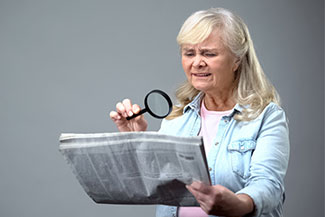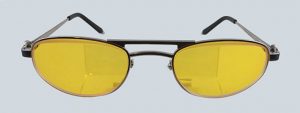With the large variety of low vision devices now available on the market, our guide will help you choose a magnifier that best suits your needs.
Before purchasing a low vision device, speak with your eye doctor or low vision specialist to determine which type of device is most appropriate for you.
Each device has its own set of advantages and disadvantages, but your main goal should be to choose a magnifier that will help you to perform your daily activities with greater ease.
Smartphones can also be used to assist those with reduced visual acuity.
Keep in mind, some devices are more complex than others, and require you to be more technologically savvy— so be sure to read up on guides of low vision devices and try out all of your options before purchasing your new device.
As you read through our guide, it is important to think about your goals and the device features that are important to you.
Types of low vision devices
Low vision devices can be categorized into five main types:
- Head-mounted magnifiers
- Handheld magnifiers
- Stand magnifiers
- Video camera magnifiers
- Telescopes
1 Head-mounted magnifiers
Head-mounted magnifiers are useful for reading, writing, sewing, and any other type of near vision work. This magnifier is secured to your eyeglasses for improved vision without having to worry about holding the magnifier in your hand.
2. Handheld magnifiers
Handheld magnifiers are compact in size and are useful for on-the-go.
This magnifier offers multiple magnification powers, and is easy to use. It is available in different sizes, weights, and features. The handheld magnifier can function as a traditional magnifying glass for reading a label on a bottle, or as an advanced electronic magnifier for extended use, such as when reading a book or magazine.
Advanced handheld magnifiers often feature options for both handheld and surface resting modes, as well as lighting and magnification adjustments, the ability to capture an image or freeze the screen, and color/contrast settings.
The Find an Eye Doctor directory can provide a list of eye doctors near you that can discuss the best options to allow you to maximize your vision and enjoy your life.
SEE RELATED: E-Scoop Glasses for Low Vision
3. Stand magnifiers
Stand magnifiers, also called closed circuit television or CCTV magnifiers, are stationary low vision aids that are useful for reading and other near vision tasks. These devices provide higher levels of magnification power, viewing mode options, and other specialized features.
Most desktop magnifiers offer computer connectivity, and split screen capabilities. Some desktop magnifiers offer a vertical viewing option if central vision is compromised or lost. They also provide peripheral reading and the ability to adjust the sharpness of an image.
4. Video camera magnifiers
Video camera magnifiers are useful for prolonged use, such as reading a book, using a computer, filing paperwork, giving presentations, self-care, and more.
These magnifiers contain a camera that can be directed at the images in the font of the room and displayed on the screen in front of you.
Additionally, this device features an option to adjust the magnification to as much as 82x, as well as color selection, and contrast settings. A mirror image display can also be used for shaving and applying makeup.
5. Telescope
Telescopes are low vision devices that are used for distance vision clarity. They are available in handheld, clip-on, mounted, or hands-free variations. Telescopes are useful for reading street signs, the board in school, watching TV or a ball game, and any other distance vision task. Some people use telescopes to read the number on the scale, or a label on a product in the supermarket.
As the market for low vision devices continues to grow, it is important to be in touch with your optometrist or low vision specialist on a regular basis to ensure that you are truly benefiting from the device you have purchased.
When chosen correctly, your low vision device can enhance your quality of life, and give you the vision you need to live your life with greater independence.
LEARN MORE: Guide to Low Vision
Schedule an appointment with an eye doctor for a comprehensive eye exam, and to discuss any questions you may have about optimizing your vision and enjoying your life.


